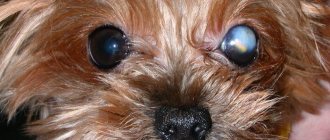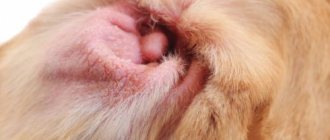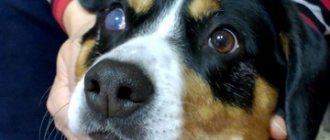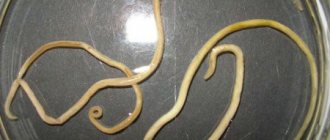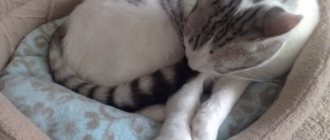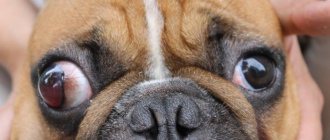If you notice how your pet constantly scratches the area in the eye area, and also has swelling of the eyelids, tearfulness is the first signal of the presence of a pathology of the organs of vision. Carefully examine the animal, or better yet, with such indicators of deviation from the norm, take it to a veterinary clinic.
Dog scratching its eyes
Why does my dog constantly scratch his eyes?
The inflammatory process is always associated with itching and discomfort that bother the dog. The pet begins to behave irritably, actively scratching the area of the organs of vision, damaging the skin and the eye itself. The inflammatory process of the organs of vision is most often caused by mechanical damage during the walking period: the ingress of a piece of grass, a splinter, small fragments of glass, can also provoke a blow from a branch or while playing with other animals. Very often, the inflammatory process is caused by conjunctivitis or an infectious disease, for example, an inflammatory process of the liver, viral etiology (various groups of hepatitis), a highly contagious bacterial infection - plague, an infectious disease caused by mycoplasma bacteria - mycoplasmosis. When a dog’s body is infected with certain parasites, it also happens that the eyes become inflamed. Such diseases manifest themselves as general lethargy, loss of appetite, high fever, and apathetic behavior. Inflammation occurs simultaneously in both eyes.
The clarity and purity of a pet’s gaze is an indicator of the absence of pathological changes in the visual organs
Non-food allergies (Atopy)
SITES OF LOCALIZATION
“Atopy” is an allergic reaction to everything else except food. For pollen, dust mites, flowers, chemical components contained in detergents, and much more.
Symptoms:
- Severe skin itching, causing great discomfort to the animal.
— Skin damage, scratching, abrasions (especially in the area of the muzzle and paws), which appear due to the fact that the dog constantly itches and tears the skin with its claws. An infection that gets into the wounds provokes the appearance of boils, hyperpigmentation, and ulcers.
- Hair loss, alopecia.
— A characteristic smell from the ears, reminiscent of fermented yeast dough.
— Focal lichenification is a structural change in the skin.
Additional signs of atopic dermatitis include:
- excessive dryness of the skin;
- immediate reaction to the allergen;
- external form of allergic otitis;
- superficial manifestations of staphylococcal infection.
The severity of the disease is determined by factors such as the area of skin lesions, the duration of exacerbations and remissions.
Treatment:
1. Corticosteroids are required. These drugs are hormonal, their action is aimed at eliminating itching, allergic swelling, and redness. Prednisolone, Methylprednisolone, Dexamethasone, etc. are most often prescribed.
2. The doctor also prescribes antihistamines: Lominal, Zyrtec, Claritin.
3. For old dogs, it is advisable to prescribe Telfast, Gismanal, Trexil - third and fourth generation drugs.
4. Tricyclic antidepressants are sometimes prescribed - Amitriptyline, Pyrazidol, Trimipramine.
5. Cyclosporine, Oxpentiphylline, Misoprostol or Fluoxetine will help cope with itching.
============================================================================================================================================================================================
Causes of eye inflammation in dogs
The reasons why inflammatory processes in the organs of vision develop:
- An infection of an infectious nature is the spread of pathogenic microorganisms, both in the body itself and at the site of infection of the eye itself.
- A non-infectious lesion is a violation of the mechanical integrity of the organs of vision, neoplasms, ectropion of the eyelid, trichiasis of the ciliary margin.
- Genetic pathologies are deviations of intrauterine development, and may also be associated with the characteristics of the breed, as a result of selection.
If eye inflammation is expressed as a symptom of an ophthalmic disease, then after visiting a veterinarian, it can be cured by following the instructions and prescription:
- blepharitis;
- conjunctivitis;
- third eyelid prolapse;
- eyelid dermatitis;
- injury;
- neoplasm.
Only a veterinarian can determine the exact cause and prescribe treatment.
With these types of disease, only the eyes are affected. Otherwise, the animal behaves actively and nothing else bothers it. Drug treatment prescribed by a doctor quickly eliminates the disease and the dog is healthy again.
If it is accompanied by other symptoms, and the inflammation does not subside within three days, then this may be due to the spread of the virus. Therefore, it is necessary to regularly vaccinate your pet to prevent the occurrence of the virus in the blood.
The presence of parasites in a dog’s body can also lead to eye inflammation. Therefore, we should not forget that helminthiasis affects not only the gastrointestinal tract. Such parasites can easily enter the heart, lungs and other organs, and the eyes are no exception. Unfortunately, it will not be possible to carry out treatment on your own, so the dog will need to be shown to a veterinarian to assess the situation, and if the eye tissue is damaged, surgical removal of the dead helminths will be performed.
Video - First signs of eye disease in dogs
Juvenile cellulite
Juvenile cellulitis is a disease of unknown etiology, characterized by inflammation of the subcutaneous tissue in puppies. The disease is rare. Mostly puppies are affected from 3 weeks of age to 4 months.
Symptoms:
- Swelling of the muzzle, usually painful.
- Swelling of the genitals, anus area.
— Subsequently, the hair around the eyes and on the chest begins to fall out.
— The mandibular lymph nodes become inflamed.
Most often, the puppy's eyelids, bridge of the nose, eyelids, chin, lips, and ear canal are affected. Sometimes other parts of the body are affected, the torso most often. The rash is painful, but the itching is not severe. The consequences of the disease are inflammation of the lymph nodes, purulent arthritis, and loss of appetite.
Treatment:
1. The disease is treated with drugs that are in the group of corticosteroids; doses are calculated individually and depend on the weight of the puppy. Prednisolone is the most commonly prescribed substance and is used orally for treatment.
2. Locally affected skin is not treated, since animals actively resist this process. If infected a second time, antibacterial treatment is carried out.
============================================================================================================================================================================================
Symptoms of major diseases
Symptoms of eye disease are largely related to the age group, general health, body stability, frequency of negative influences, cause and stage of infection. Symptoms may include:
- discharge of pus, lacrimation;
- accumulation of fluid in the corners of the organs of vision (exudate);
- formation of scabs and scabs on the skin of the eyelid;
- swelling and redness of the eyelid;
- itching and burning;
- increased blinking frequency;
- scleritis, leukoma, opacity of the corneal layer;
- increased body temperature, weakened and lethargic state of the animal;
- impaired pupillary reactions in light, photophobia;
- blepharospasm;
- decreased vision.
Pus discharge from a dog's eye indicates a disease
What you need to know! Be sure to take your pet to the veterinarian if you notice these symptoms. After diagnosis and examination, the specialist will make a diagnosis and prescribe the necessary medications.
Mite infestation
Symptoms:
— Often the animal is worried about the attached tick: it itches, shakes its head if the tick has got into the ear.
— Rapid rise in body temperature to 41-42°C. This is the dog’s body’s response to the introduction of the parasite.
— At the site of the bite, two to three hours after removing the parasite, pronounced local redness is observed.
- Swelling, increasing in radius from the center of the bite, increased skin temperature in this area, redness, itching and pain.
— The animal licks and scratches the bite sites.
— Animals refuse to eat, show drowsiness and apathy.
— If a lump appears at the site of the bite, this may be the result of an allergy to the saliva of the parasite or infection of the wound or the tick head remaining in the wound. Hair may fall out at the site of the bump, and the dog reacts painfully to touching it. Purulent inflammation at the site of the bite appears due to the introduction of pyogenic microbes into the open wound.
— Some of the listed symptoms may appear: trembling, thirst, shortness of breath, pale mucous membranes, abdominal pain, foul odor from the mouth, blood in the urine, vaginal bleeding (in bitches), impaired motor reflexes: unsteadiness of gait, paralysis of the hind limbs (“tick-borne”) paralysis"), dysphonia (the dog cannot bark), dysphagia (lack of swallowing), sometimes vomiting and diarrhea and some others.
Treatment:
1. Remove the tick.
2. Disinfect the wound.
3. Use of antiparasitic drugs after consultation with a veterinarian.
Prevention:
- Anti-tick drops.
— Antiparasitic collar.
— Protective overalls.
============================================================================================================================================================================================
Types of visual pathologies in dogs
Blepharospasm
Involuntary contraction of the orbicularis oculi muscle (blepharospasm) - repeated contraction of the muscles of the eyelid. The dog begins to avoid light, and the eyes secrete exudate. The eyelid swells and becomes painful.
Keratitis
Keratitis is an infection and inflammation of the cornea due to damage. Keratitis is often caused by infectious pathogens such as bacteria, adenoviruses, fungi, and thelaziosis (helminths). The dog begins to squint his eyes, scratch his eyes with his paws, become nervous and behave restlessly.
Keratitis is very dangerous and can lead to serious complications if not treated correctly.
Prolapse
Prolapse is a deviation in the placement of the lacrimal gland of the third eyelid. After the loss, inflammation and swelling occur. A characteristic feature of this deviation is that it can appear and go away after some time.
It is believed that prolapse has a hereditary predisposition
Conjunctivitis
Conjunctivitis is an inflammatory process of the film membrane (conjunctiva). The animal blinks frequently, constantly touches its eyes with its paws, and whines. In most cases, it has a viral and bacterial form.
Conjunctivitis is the most common eye disease in dogs.
Cataract
Cataract is a pathology of the light-refracting structure of the eye, characterized by clouding of the lens and loss of its transparency. During clouding of the lens, the dog is careful in movement and completely switches to auditory and olfactory perception. The main reasons for its occurrence can be considered heredity and old age.
Cataracts in dogs develop in old age and are often inherited
Blepharitis
Blepharitis is an inflammation of the skin tissue of the eye due to infection, insect bites, the presence of parasites, and burns of various types.
Inflammation of the eyelids occurs against the background of allergic reactions, injuries, infections
Entropion and eversion of the eyelid
Eversion of the lower eyelid (ectropion), inversion of the eyelid (entropion) - inversion and inversion of the eyelid, a deviation that mainly predominates in dogs. Soreness appears, the conjunctiva dries out, purulent discharge and excess tear fluid occur.
Pathological changes in entropion and ectropion of the eyelid occur in the eyelid itself in breeds with folded skin and a large palpebral fissure
Dermatitis of the century
Dermatitis of the eyelid – provokes the occurrence of pathologies. The tissues acquire a reddish tint, peel, pus is released, swelling appears - all this actively develops conjunctivitis and keratitis.
Dermatitis affects the tissue around the eye and provokes the active development of other diseases
Ulcerative keratitis
Ulcerative keratitis. After the inflammatory process, the affected corneal tissue becomes thinner, and small ulcers occur. The contours of the pupil blur, the cornea gradually becomes cloudy, and the membrane of the eyeball acquires a red tint. The dog actively scratches its eyes, lacrimation and pus appear.
Damage to corneal tissue by ulcers
Lens luxation
Lens luxation is a dislocation of the lens from its normal position. Injury to the pupil and movement to another place, which often leads to deformation of the eyeball itself. It occurs after a complication of an infectious disease, injury, glaucoma, cataract and is often hereditary. Basically, complete loss of vision occurs.
Displacement of the pupil from the center to the side
Eyeball prolapse
Eyeball prolapse is a dislocation of the organ of vision beyond the eyelid. Appears due to cranial damage, intracranial pressure or muscle tension. More often, infection occurs with subsequent loss of vision.
Strong extension of the eyeball beyond the eyelid
Hives
Hives are an acute allergic reaction that manifests itself as a rash of small blisters on the surface of the skin.
Symptoms:
- Small swellings appear on the ears, face or even tongue, resembling blisters or traces of nettle burns.
“Sometimes hair starts to fall out in these places.
— Since the dog experiences severe and constant itching, it begins to constantly scratch and even scratch its skin, as a result of which numerous scratches appear on it, especially numerous on the face.
- In more severe cases, the animal experiences distinct difficulty in inhaling air. This happens due to swelling and swelling of the mucous membranes of the upper respiratory tract.
— In the most dangerous situations, the tissues of the pet’s face are literally “swept away,” and the lips and nose become swollen.
Treatment:
1. The main means of combating an allergic reaction in the form of urticaria is to take antihistamines (Suprastin, Zyrtec, Tavegil, etc.).
2. In severe cases, accompanied by swelling and difficulty breathing, an infusion of 10% calcium chloride solution and the use of adrenaline are prescribed.
Take your pet to the vet immediately if you notice the following:
- When your dog strains and wheezes while trying to breathe.
- In cases where the face and lips swell with urticaria.
- You should also contact a veterinarian when the clinical picture of urticaria does not subside a day after the first signs of pathology appear.
============================================================================================================================================================================================
Age-related eye pathologies
The older the dog, the more signs of visual impairment may appear, but these are considered normal. The main thing is to exclude the presence of a serious pathology, then nothing threatens the health of your pet.
Normal features include:
- Iris atrophy. Formed due to atrophy of the iris muscle. The pupil becomes “ragged” at the edges, and the iris tissue becomes thinner. Occurs in animals older than ten years, especially in small purebred dogs.
- Nuclear sclerosis. The core of the lens becomes denser, and can create the appearance of cloudiness in the central part. It is mistakenly mistaken for cataracts, but an experienced specialist, using the necessary methods, can always distinguish the disease from age-related changes in the animal.
Nuclear sclerosis of the lens and atrophy of the iris, which appears in dogs with age
Retinal diseases and problems
This category of ophthalmic problems in dogs is common to all breeds. Dogs of all age categories suffer from similar pathologies, but animals over 5-6 years of age suffer more than others. The causes of such diseases are injuries to the eyes and muzzle, hemorrhages in the skull. Often diseases develop at the genetic level and are hereditary.
Retinal detachment
The retina can peel off under the influence of traumatic factors, when exposed to harsh bright light, when looking at the sun or too bright sources of fire. Retinal detachment can occur in all breeds of dogs, regardless of age.
This disease is characterized by a rapid course and a cautious prognosis. It can result in the dog becoming completely blind if timely treatment measures are not taken. For this purpose, a course of drug therapy is prescribed using anti-inflammatory and antibacterial drugs. At the same time, surgical manipulations can be prescribed, including ophthalmic surgery.
Retinal atrophy
Retinal atrophy is more depressing for the dog and its owner, since it cannot be treated. It manifests itself as a gradual loss of vision, initially in darkness. Subsequently, vision becomes weak even in daylight.
There is no effective treatment for canine retinal atrophy.
Foreign object in the eye
Mechanical damage from a blow from a branch, the introduction of a splinter or grass, a small piece of glass or a pebble is often encountered while walking. Tearing may be moderate at first, but over time it turns into inflammation, and if attention is not paid in time, this can develop into a dangerous disease, and sometimes can lead to loss of vision. A visit to a veterinarian is the solution to this problem. Because it is not always possible to help your pet on your own due to the lack of necessary equipment to remove a foreign body from the eye.
Forbidden:
- Try to remove shards of metal or glass with your own hands, especially particles that are located in the cornea itself. Self-extraction may damage the eyeball;
- try to apply pressure or rub the eye;
- use hard objects (cotton swabs, toothpicks).
Foreign body in the eye. How to delete?
Tearing common to certain dog breeds
Tearing is normal in some breeds. For example, brachycephalic dogs, long-haired dogs, as well as in breeds with an enlarged palpebral fissure, the secretion of tear fluid will be normal. These breeds require regular care and careful eye treatment. Breeds with this feature include:
- Saint Bernard;
- bloodhound;
- mastiff;
- Shar Pei:
- cocker spaniel;
- bullmastiff;
- bulldog;
- chow-chow;
- Basseta;
- decorative dogs (Yorkshire terrier, Pekingese, etc.).
Bulldogs are prone to lacrimation
Pododermatitis
Pododermatitis is an inflammation of the delicate skin of the paws between the toes.
It occurs most often between October and March, when roads and paths are sprinkled with the reagent. As a rule, this is salt, but reagents with added chemicals are most often used.
The most susceptible breeds are those with short hair and often without undercoat (Dobermans, Great Danes, Shepherds, Bulldogs, Pinschers, Toy Terriers, Chihuahuas, etc.).
Symptoms:
— The dog constantly licks its paws, chews them, and limps.
— Paw pads are red and wet.
— The disease manifests itself as sores on the pads.
- Vesicles filled with blood form on the paws.
- A characteristic sign is swelling of the paws.
Treatment:
1. First of all, you don’t need to wash your paws with an alkaline solution every time you walk: soap, shampoo or gel. With this treatment, the skin becomes susceptible not only to reagents, but also to pathogenic bacteria, and this can lead to more serious diseases.
2. Antiseptics and antibacterial agents are prescribed for treatment.
Prevention:
— Before a walk, rub the pads with paraffin or a special product that is sold at a veterinary pharmacy.
— After a walk, wash off the reagent and all dirt with running water, without any means.
- Use shoes for animals.
============================================================================================================================================================================================
Dog eye examination
It is necessary to regularly examine your pet, and do not forget to pay attention to the eyes. A large dog can be examined by placing it on the floor, and a small dog can be examined on a table by sitting or laying it down. Carefully, without effort or pressure, use the fingers of your free hand to slightly open the palpebral fissure. This will allow you to examine your dog's eyes for the presence of a foreign body or determine the type of discharge from the eye.
Examination of the organs of vision must be done very carefully so as not to harm the pet.
What you need to know! If the dog does not allow you to approach him or shows aggression, trying to defend himself, then you need to carefully secure the mouth with a wide braid. In this case, a muzzle may make inspection difficult.
A healthy animal is distinguished by clarity, cleanliness, with the absence of excessive eye fluid, as well as the presence of a transparent cornea of the eye. The outer membrane of the eye (the tunica albuginea) is white, without inclusions or bloody stains. If there is a characteristic change in the eye, then this indicates the spread of the pathology.
Regular inspection is carried out in a well-lit place, preferably in the morning and after walking. It is necessary to examine the condition of the eyeball as a whole, the conjunctiva, the absence of redness, swelling, the absence of a foreign body, the normal position of the organs of vision, the reaction of the pupil, the absence of various types of formations.
Every year, take your dog to see an ophthalmologist to examine the condition of the cornea and its internal structure, and to rule out the presence of ophthalmological pathology. If the cornea has changed color, it may be an ulcer or injury. Deformation of visual functions, blepharospasm, lacrimation, and the appearance of a nictitating membrane are symptoms of an ophthalmological disease. Yellowing of the conjunctiva indicates a problem with the liver, possible hepatitis, helminthiasis. Blue discoloration is, in turn, a symptom of intoxication poisoning in a dog.
The dog must be taken to an ophthalmologist annually
For preventive purposes, you can wipe your pet's eyes with a strong tea infusion without additives and chamomile infusion.
Dermatophytosis (lichen)
Dermatophytoses are infectious diseases of keratinized tissues (skin, hair, nails) caused by fungi of the Microsporum, Trichophiton or Epidermophiton species.
LOCALIZATION PLACES
In everyday life, all these diseases are called lichen. Ringworm is transmitted to humans!
There are several types of dermatophytoses, similar in symptoms:
- ringworm;
- trichophytosis;
- microsporia;
- favus.
Symptoms:
1. Peeling of the skin with signs of hair loss.
2. Inflammatory process on the skin, sometimes with purulent discharge.
3. Itching.
4. Baldness.
Treatment:
1. For small lesions, ointments are used
2. Lime sulfur solution; miconazole solution; povidine iodide; rinsing solutions containing chlorhexidine. The dog's ears are treated separately using cotton swabs.
3. In especially severe cases, when large areas of the body are affected, fulcin, grisin and biogrisin are used.
============================================================================================================================================================================================
Treatment of eye diseases in dogs, medications for eye treatment in a veterinary kit
Treatment of conjunctivitis
When treating conjunctivitis, on the recommendation of a veterinary specialist, the owner can use these drugs:
- antibacterial drops ("Tsiprovet" - 1-2 drops/4 r per day for 1-2 weeks; "Bars" - 1-2 drops/4 r per day; "Anandin" - 2 drops/2 r per day);
- antibacterial ointment (“Conjunctivin” - 2-3 drops/3 times per day for 5-10 days).
Eye drops "Tsiprovet"
Treatment of an injured eye
If an eye injury is detected in a dog, first aid is necessary. When examining the eye and detecting a foreign body (splinter, grass, fragments, pebbles), it is necessary to rinse the eye with an anesthetic (Oxybuprocaine hydrochloride, Benoxy - 1-4 drops), and only then proceed to remove the object. With such an intervention, do not forget about the use of antibacterial drugs.
Before starting treatment, you need to visit a veterinary clinic, only there they will examine the dog and prescribe the correct treatment. The specialist will first prescribe means for washing the eyes from purulent accumulations, and will tell you what materials to use to treat the eyes. The next step is to prescribe eye drops, which are used strictly after washing the eye from pus. Antibacterial and anti-inflammatory drugs are prescribed for infectious diseases. Vitamins can also be prescribed to strengthen the immune system. During the treatment period, special socks and a collar may be used to limit access to diseased areas.
What you need to know! Try to strictly adhere to the specialist’s instructions, especially with regard to the dosage of eye drops, since dogs have very developed sensitivity of the visual organs.
It is necessary to instill medications according to the veterinarian's prescription.
In case of eye injury, first aid is provided, so the first aid kit should always have painkillers (1-2% novocaine solution) for disinfection (1% brilliant green solution). The treated surface is covered with a sterile bandage, and the dog is taken to a veterinary clinic.
Treatment of blepharitis
Inflammation of the eyelid (blepharitis). Usually provoked by careless scratching, a tick bite, or a bruise. Bleeding ulcers at the base of the eyelashes, with the appearance of dried crusts and scales, at the same time there is thickening and redness of the eyelids, loss of eyelashes, severe lacrimation - a manifestation of blepharitis.
The following drugs are used for treatment:
- "Sofradex" (strictly as prescribed by the doctor);
- “Lakrikan” (1-2 drops 2-3 times a day for 8-10 days);
- "Calendula" 10% ointment for external use;
- “Hydrocortisone acetate” (0.2 ml 2-3 times a day).
Video - How to put drops in a dog's eyes
Treatment of inflammation of the conjunctiva
Inflammation of the conjunctiva. It occurs due to a deficiency of various vitamins and minerals in the dog’s body, or the penetration of a foreign body.
The following drugs are used for treatment:
- "Bonkharen" (1-2 drops every 2-12 hours for 5-7 days);
- “Veteritsin gel” (3-4 times a day);
- “Desacid” (2-4 drops 3-4 times a day for 7-10 days);
- “Dekta-2” (2-3 drops 2-3 times a day for 5-10 days);
Eye drops "Desacid"
Treatment of keratitis
Keratitis. Inflammation causes clouding of the cornea of the eye, which, without proper treatment, can lead to perforation of the cornea itself and cause the appearance of ulcers and abscesses. Inflammation of the cornea can be superficially purulent, deeply purulent, superficially vascular, catarrhal, phlyctenulous, punctate, and superficial.
Depending on the type of inflammation, medications are used:
- "Lacrimin" (3-4 drops daily);
- “Forvet” (1 drop 4-5 times a day for 7-30 days);
- "Sofradex" (strictly as prescribed by the doctor).
Video - Prevention and treatment of eyes in dogs
Pyoderma
Pyoderma in dogs is a purulent bacterial infection of the dog's skin. Pyoderma can be superficial or deep.
Symptoms:
- The appearance of itching in the pet, an unpleasant odor from the skin, redness and inflammation of the skin, the appearance of purulent discharge on the skin.
— The dog becomes nervous, restless, cannot find a place for itself, chews itself, some of them whine, squeal.
— The skin is hyperemic, thickened, compacted, or in some places, on the contrary, softened and loose.
- The skin is covered with a wet film, pus, or a dry crust.
- The coat is absent or becomes much thinner, which occurs as a result of scratching, gnawing, and rubbing against objects.
Treatment:
1. External treatment of affected skin areas with antiseptic solutions and local wound-healing anti-inflammatory/antipruritic agents. If the damage is significant, baths and bathing with antiseptic shampoos are prescribed.
2. A course of long-term antibiotic therapy lasting from several weeks to several months is also usually required. In severe cases, two types of antibiotics are prescribed.
3. Treatments against ectoparasites are also mandatory (this is an important stage in the treatment of pyoderma, and it is required even in cases where no ectoparasites have been identified!).
============================================================================================================================================================================================
